
The indestructible grasses
Resilient and easy to grow
Contents
The grasses possess the grace and lightness of wild herbs, forming tall clumps or small fluffy cushions that are perfect for adding verticality and movement to perennial borders or softening the outlines of somewhat rigid modern constructions. Grasses offer an astonishing diversity of coloured and variegated foliage, complemented by very graceful flowerings. Some of them are truly easy to grow, have a rapid growth rate, and are suitable for novice gardeners. They can adapt to a plethora of growing conditions and various exposures.
Don’t have a green thumb but are tempted by growing grasses? Discover here a selection of resilient grasses to ensure success in your garden
Miscanthus: Graphical and Structural
Large structural grasses, the Miscanthus are making their way into natural gardens to enhance and structure flowerbeds, as well as into more modern spaces for their graphic look or even in exotic-style gardens where their impressive clumps quickly make an impact. In fact, some of the tallest varieties can create a stunning visual effect, such as the very tall Miscanthus giganteus, which can reach up to three metres.
Miscanthus require little, thrive in various conditions, and only need a cut back to the ground at the end of winter. They form large clumps of fine, upright leaves and produce a generous flowering in late summer, with colours ranging from silver to pink or purple, depending on the variety.
- Miscanthus for full sun: all Miscanthus love the sun! For example, plant the bright Miscanthus sinensis ‘Variegatus’ variegated with cream and soft green, the Miscanthus sinensis ‘Sirene’ which is covered in September with numerous mahogany-red inflorescences, or the Miscanthus sinensis ‘Afrika’ that stands out with its intense bright red and orange hues.
- Miscanthus for partial shade: one of the few that thrives in this exposure is the Miscanthus sinensis ‘Kleine Fontäne’, which will take on a red tint at the end of summer.

Miscanthus sinensis ‘Variegatus’, Miscanthus sinensis ‘Sirene’ and Miscanthus sinensis ‘Afrika’
→ For further reading, check our complete guide MISCANTHUS: PLANTING, GROWING AND CARING FOR
Read also
Grasses: which variety to choose?Carex: foliage with an incredible diversity of colours
Carex, known as sedges, belong to the family Cyperaceae, like papyrus. Among grasses, this genus boasts the greatest diversity of foliage colours. Carex are generally very hardy, require almost no maintenance, and are extremely easy to grow, robust and nearly indestructible!
- Carex for full sun: Carex comans ‘Bronze Form’ with its coppery-brown colour, golden sedge elata ‘Aurea’ which thrives on banks or in marshy ground, or Carex flagellifera ‘Kiwi’, spectacular for its almost fluorescent light green foliage.
- Carex for partial shade: Carex brunnea ‘Jenneke’ with its fine yellow-green foliage edged in dark green that grows in cool to moist soil, or Carex brunnea ‘Aureovariegata’ with its remarkable graphic quality due to its fine light green leaves edged in golden yellow.
- Carex for shade: some Carex need to escape the sun’s rays to thrive. Notable examples include Carex plantaginea or broad-leaved sedge, and the woodland sedge Carex sylvatica.
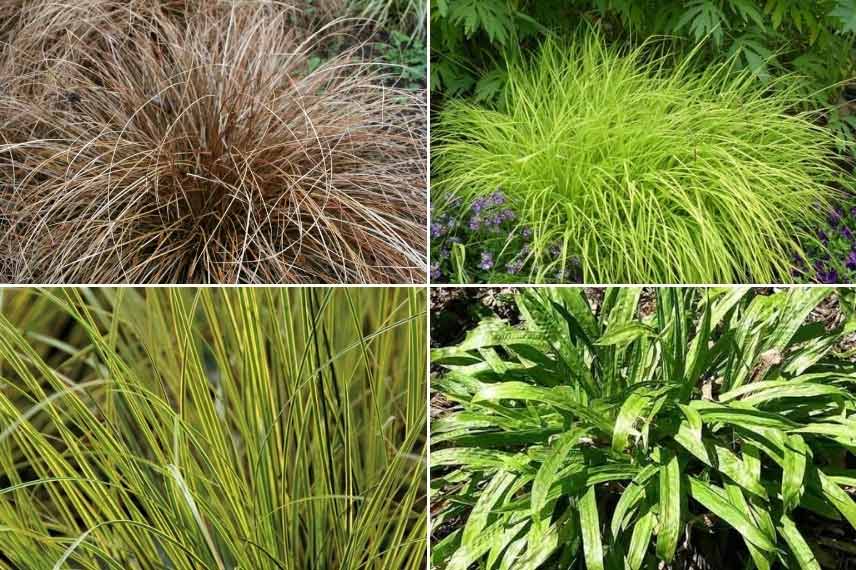
Carex comans ‘Bronze Form’, Carex elata ‘Aurea’, brunnea ‘Aureovariegata’ and Carex plantaginea
→ For further reading, check our complete guide CAREX: PLANT, DIVIDE AND MAINTAIN
Discover other Ornamental grasses
View all →Available in 0 sizes
Available in 1 sizes
Available in 0 sizes
Available in 0 sizes
Available in 0 sizes
Available in 1 sizes
Available in 0 sizes
Available in 1 sizes
Available in 1 sizes
Available in 1 sizes
Fescues: grasses for the sun!
Fescues are grasses for dry soils, ideal for full sun exposure. They form compact, tufted clumps with numerous very fine leaves. Hardy and undemanding, fescues can withstand almost anything but do not appreciate wet, clayey soils. They are therefore perfect for rockeries, slopes, or even in pots.
- Fescues for full sun: all fescues prefer full sun, such as the well-known Festuca glauca or Blue Fescue, and Festuca glauca ‘Golden Toupee’ with straw-yellow tones.
- Fescues for partial shade: take advantage of it, the Festuca valesiaca ‘Glaucantha’ is one of the few fescues that can tolerate partial shade.
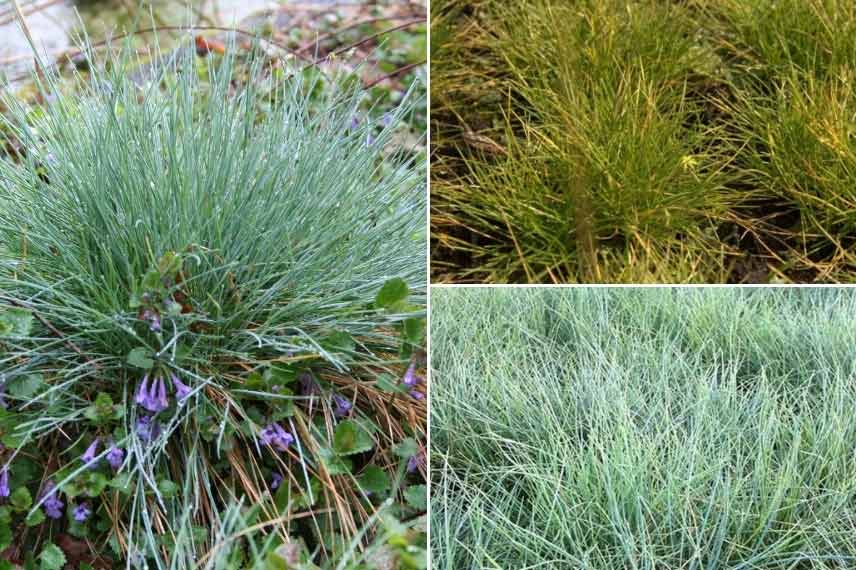
Festuca glauca, Festuca glauca ‘Golden Toupee’ and Festuca valesiaca ‘Glaucantha’
→ For further reading, check our complete sheet on FESCUE: PLANTING, MAINTENANCE
Read also
6 grasses for a North-facing gardenStipa: graceful angel's hair
Easy to grow, Stipa only fear excess water. They are therefore outstanding, hardy grasses that thrive in well-drained soil. They quickly and easily dress sunny, windy, and arid areas of gardens. The foliage of Stipa, evergreen, very fine, and wavy, is not pruned at the base like other grasses but is combed at the end of winter to remove dry leaves.
- Stipa for full sun: Stipa generally prefer full sun. Plant the Stipa tenuissima ‘Pony Tails’, well-known among gardeners, or the incredible Stipa arundinacea ‘Sirocco’ with its reddish-orange hue in summer.
- Stipa for partial shade: the Stipa barbata can be planted in full sun or partial shade, even in dry, calcareous, and poor soil in summer.
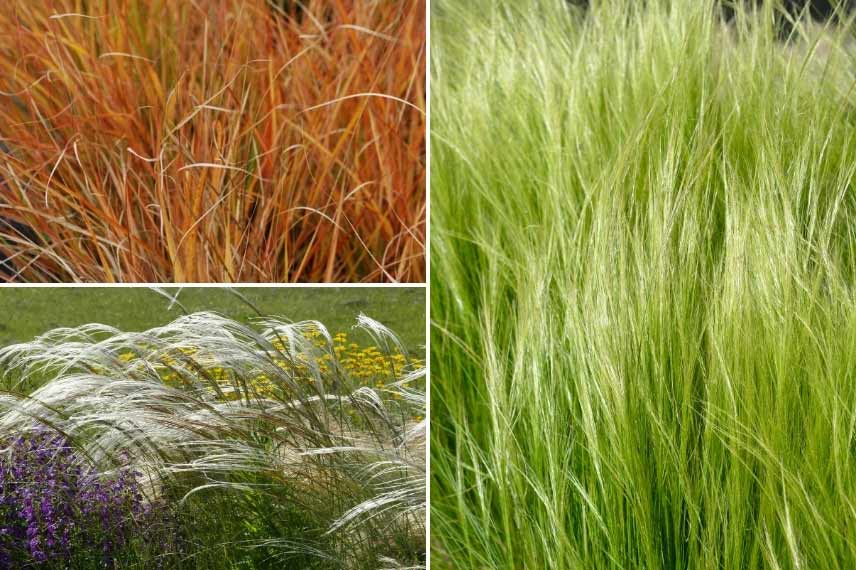
Stipa arundinacea ‘Sirocco’, Stipa barbata, and Stipa tenuissima ‘Pony Tails’
→ For further reading, check our complete guide on STIPA, ANGEL HAIR: PLANTING, PRUNING, MAINTENANCE
Panicum: for stunning autumn scenes
Perennial and low-maintenance, the Panicum are other grasses that are very easy to grow and maintain. Valuable for adding verticality to the garden with their upright and stiff habit, Panicum are also interesting for the colour of their leaves. Depending on the variety, they can be red, orange, blue, or green. Their small brown flowers also bring a lovely lightness to the borders.
- Panicum for full sun: generally, it is better to place Panicum in full sun. For example, plant the elegant Panicum virgatum ‘Heavy Metal’ or Panicum virgatum ‘Kulsenmoor’ which will turn red in autumn.
- Panicum for partial shade: one of the few that can tolerate a partially shaded position is the Panicum virgatum ‘Squaw’, which is very ornamental due to its blue-tinged foliage.
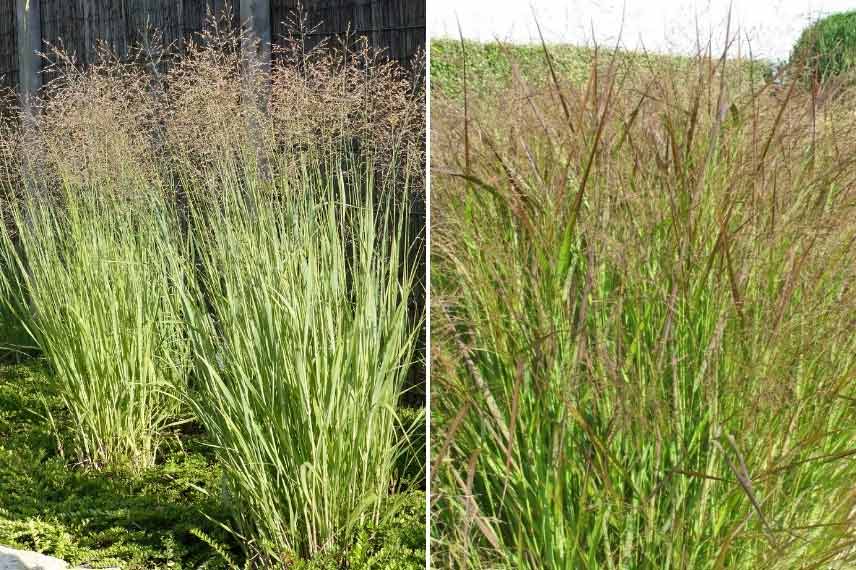
Panicum virgatum ‘Heavy Metal’ and Panicum virgatum ‘Squaw’
→ For further reading, check our complete guide on Panicum: Planting, Cultivation, Division, and Care
Cortaderia: majestic plumes
With their large feathery flower spikes, the Cortaderia, also known as Pampas Grass are making a comeback. Monumental, graceful, and architectural, they are very easy to grow grasses, to the point of being considered invasive. Therefore, caution is needed in their use: their spread leads to significant ecological changes in some regions, threatening local flora. They are large grasses that are virtually foolproof, capable of growing anywhere and requiring almost no maintenance… except for controlling their expansive nature!
- The Cortaderia for full sun: Cortaderia prefer to grow in full sun. Opt for the pink Pampas Grass Cortaderia selloana ‘Rosea’ or for smaller gardens, the dwarf variety Cortaderia selloana ‘Tiny Pampa’‘, measuring 60 cm in all directions!
- The Cortaderia for partial shade: the Small Pampas Grass Cortaderia richardii, smaller, more compact, and flowering earlier in ordinary soil, even poor and dry, but also moist and even saline.

Cortaderia selloana, ‘Tiny Pampa’ and ‘Rosea’
→ For further reading, check our complete guide PAMPAS GRASS, CORTADERIA: PLANTING, CARE
Deschampsia: beautiful and airy
Producing clouds of vapour-like flowers in summer, the Deschampsia, commonly known as tufted hair grasses, form trailing clumps of very fine evergreen foliage. These grasses thrive in all exposures and soils, are truly easy to care for, require little maintenance, and have no enemies. Extremely hardy, they display shades of green, blonde, or purple and remain decorative throughout winter, when frost freezes them in their graceful beauty.
- Deschampsia for sunny spots: try among others the Deschampsia flexuosa ‘Tatra Gold’ with very fine acid yellow-green leaves, or Deschampsia cespitosa, vapour-like and silver-green.
- Deschampsia for partial shade: the Deschampsia flexuosa will easily tolerate light shade, just like the tufted hair grass ‘Northern Lights’, a compact variety with tricolour foliage.
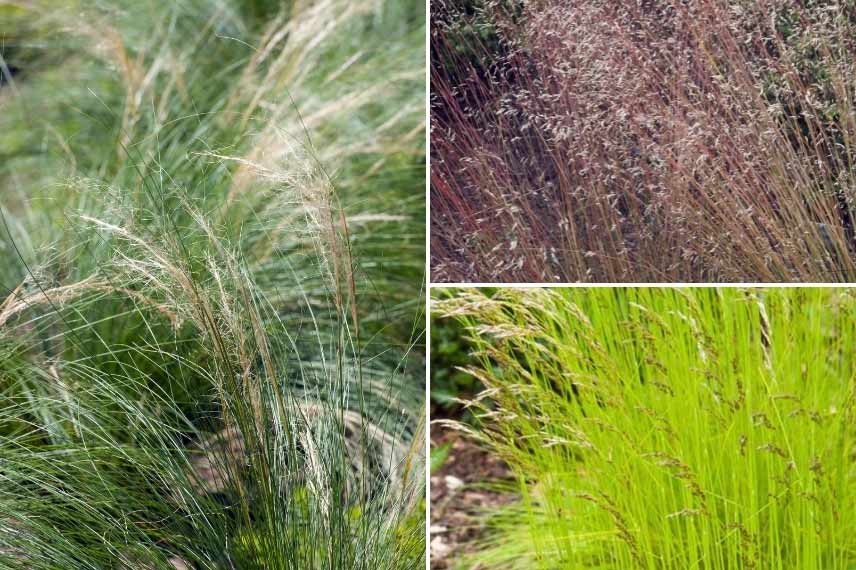
Deschampsia cespitosa, inflorescences of Deschampsia flexuosa and Deschampsia flexuosa ‘Tatra Gold’
→ For further reading, check our complete guide on DESCHAMPSIA, TUFTED HAIR GRASS: PLANTING, CARE, AND COMPANION PLANTING
- Subscribe!
- Contents
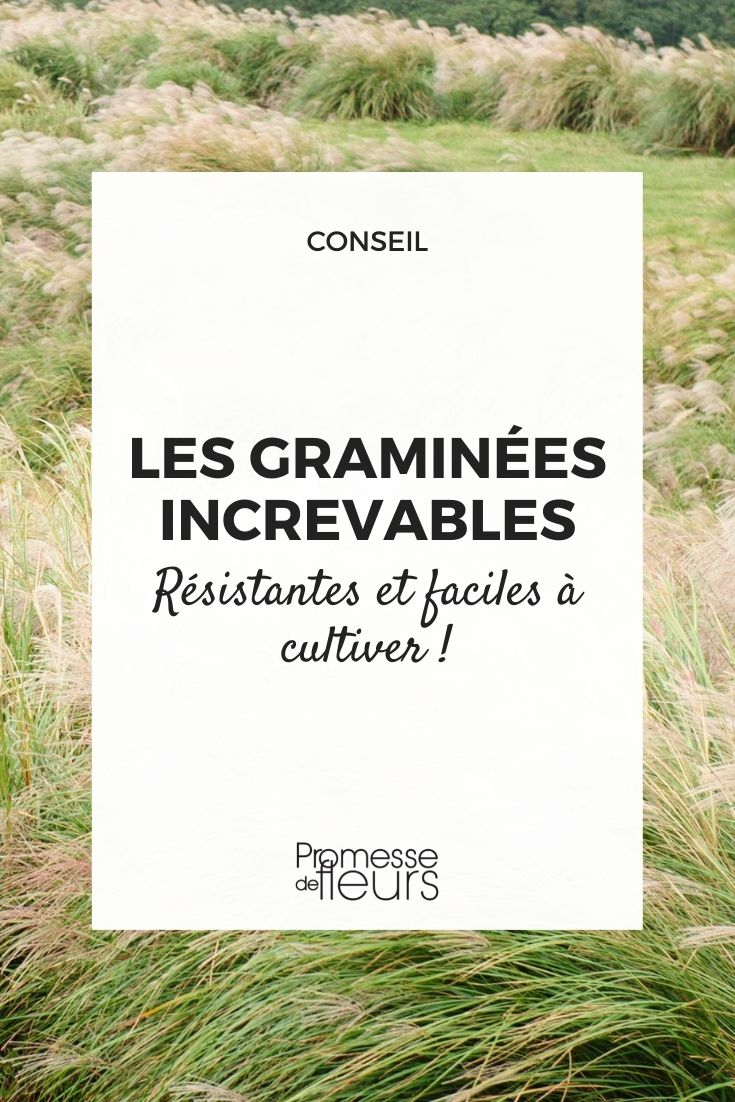
































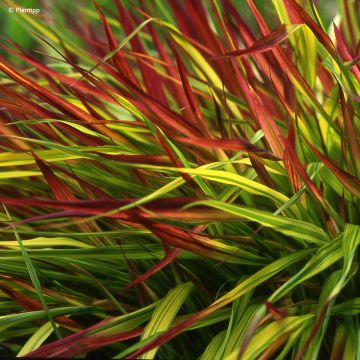
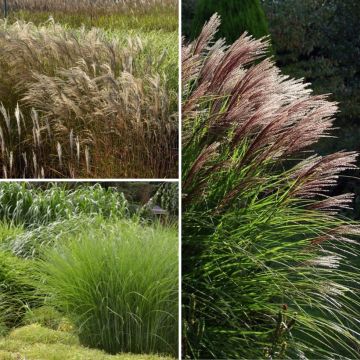
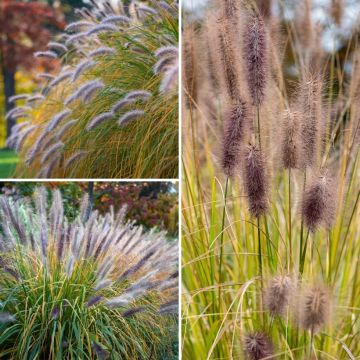
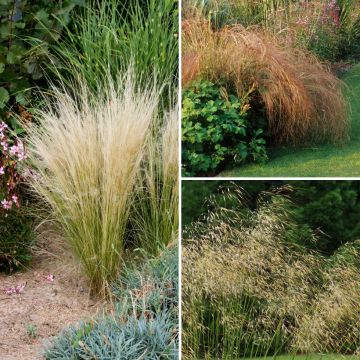
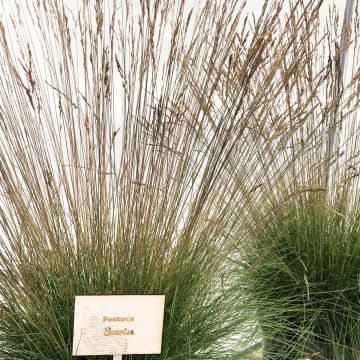
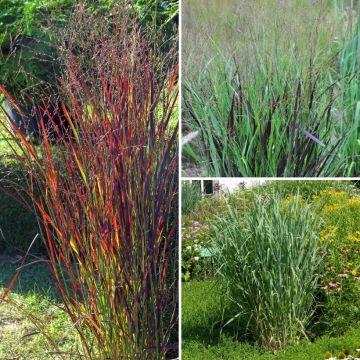
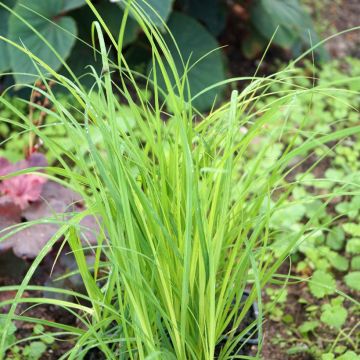

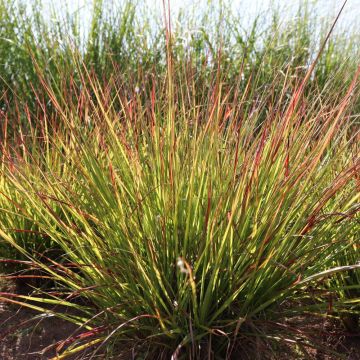
Comments